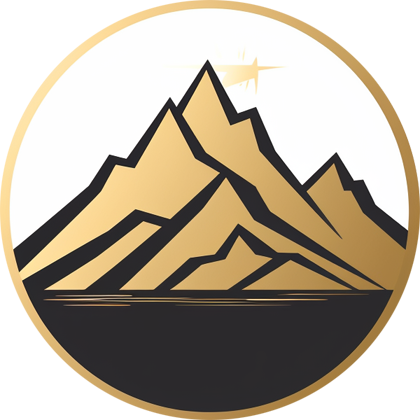
Alaska is the second largest gold producer in the United States, after Nevada. Read in this article about the history of gold mining in Alaska, about its major active gold mines and other facts and figures about gold mining in AK.
Contents
- Is there Gold in Alaska?
- Where is Gold in Alaska?
- Why is there so Much Gold in Alaska?
- What is the History of Gold Mining in Alaska?
- How Much Gold Has Been Mined in Alaska?
- What is the Current State of Gold Mining in Alaska?
- How Many Gold Reserves are in Alaska?
- What Companies Mine Gold in Alaska?
- Where are New Gold Mines Explored or Developed in Alaska?
- Is it Legal to Mine Gold in Alaska?
- Where Can I Pan for Gold in Alaska?
- Is There Gold in Other US States?
Is there Gold in Alaska?
Yes. Gold production is mainly in central Alaska around Fairbanks and in the panhandle at Juneau.
Alaska produced 20 tonnes of gold in 2022. This is around 13% of the US gold output. From a peak of 31 tonnes, the production feel until 2020 to 20 tonnes, at which level it stabilized. This is a decline of 38%. Total gold production from 1880 to 2022 stands at 54m ounces.
Currently there are 4 gold mining operations in the state; three underground, one open pit. The US Geological Survey lists more than 8,000 gold deposits in Alaska. Unique to Alaska is its placer mining industry, with more than 200 placer mines, contributing to 8% to the state’s gold output.
Key Takeaways:
| Fact | Explanation |
|---|---|
| Remember | second biggest gold producer in the US, countless placer mines |
| Gold Deposits | Yes |
| Discovery Year | 1849 |
| Discoverer | Petr Doroshin |
| Gold Mining Industry | Still active |
| Major Gold Locations | In central Alaska, around Fairbanks, and in the southeast, close to Juneau |
| Major Active Gold Mines | 4 mining operations, with Fort Knox the biggest operation |
| Mining Companies | 4 mining companies |
| Panning Locations | All over the state, many locations allow gold panning |
Where is Gold in Alaska?
Gold has been mined throughout Alaska, except in the vast swamps of the Yukon Flats and along the North Slope between the Brooks Range and the Beaufort Sea.
Areas near Fairbanks, Juneau, and Nome have produced most of Alaska’s historical output and provide all current gold production as of 2024.
The geography of Alaska in terms of gold deposits includes known gold-bearing rocks, with most gold being found in stream deposits and placer mines. The U.S. Geological Survey has provided scientific data necessary to manage the state’s gold and other mineral resources, with most gold in Alaska coming from the sands and gravels of streams and rivers, known as placers.
The following map of Alaska shows the four gold production operations and four gold mine developments.
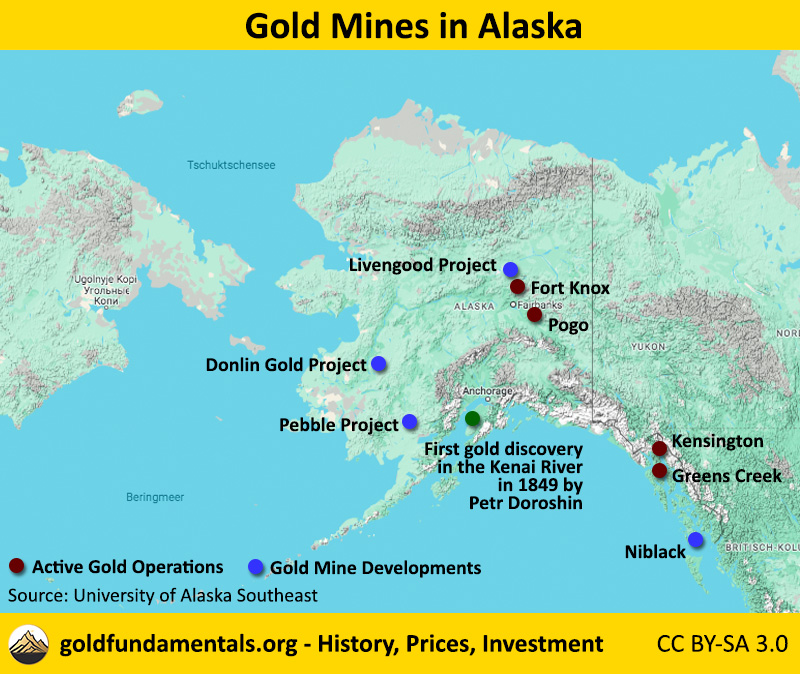
Sources: University of Alaska Southeast
Why is there so Much Gold in Alaska?
The presence of significant amounts of gold in Alaska is largely due to its unique geological history. Here are some key factors:
Tectonic Activity: Alaska is situated along the Pacific “Ring of Fire,” a zone of high tectonic activity, including earthquakes and volcanic eruptions. This activity has led to the formation of numerous mineral deposits, including gold.
Glaciation and Erosion: The state has undergone extensive glaciation and erosion over millions of years. These processes have exposed rock layers, concentrating gold in placer deposits, which are relatively easy to mine. Glacial movements also transported gold and deposited it in various locations.
Geological Formations: Alaska’s geological formations are favorable for gold deposits. The state has a variety of rock types, including igneous, metamorphic, and sedimentary rocks, which are often associated with gold.
Historical Gold Rushes: The discovery of gold in the late 19th and early 20th centuries led to several gold rushes in Alaska. These events brought thousands of miners to the region, who found substantial amounts of gold, confirming the abundance of the resource.
Continued Exploration: Even today, Alaska remains a focus for gold exploration and mining, with new deposits still being discovered and developed. The vast and relatively under-explored landscapes of Alaska continue to offer potential for significant gold findings.
The combination of these geological and historical factors has contributed to the abundance of gold in Alaska, making it one of the richest areas in the United States in terms of gold resources.
Source: National Park Service
Check out the video about a modern day mine:
What is the History of Gold Mining in Alaska?
In the early days, before Alaska became a part of the United States, the region was under Russian control. It was not until after the United States purchased Alaska from Russia in 1867 that gold mining began to take off.
Who Discovered Gold in Alaska?
Gold was discovered in various parts of Alaska by different individuals.
A Russian geologist, Petr Doroshin, is often credited with the first discovery of gold in Alaska in 1848. He found placer gold in the Kenai River on the Kenai Peninsula while exploring for the Russian-American Company.
When did Gold Mining Start in Alaska?
Gold mining started in 1870s, southeast of Juneau.
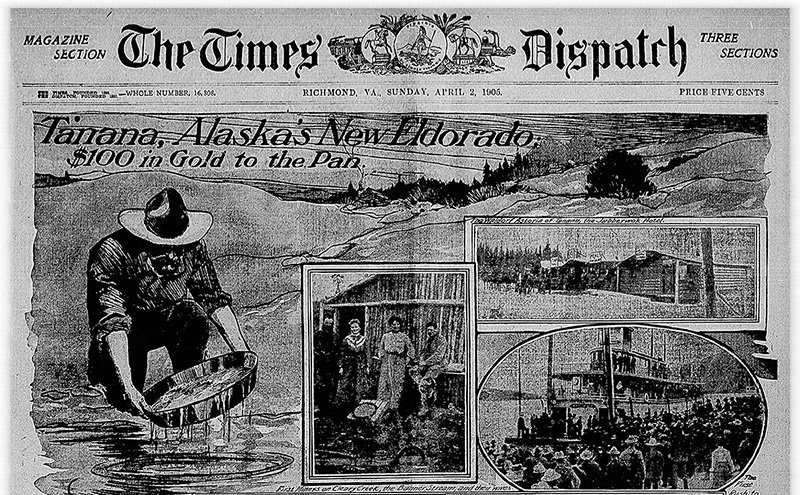
However, the real turning point came with the Juneau Gold Rush of 1880, sparked by Joe Juneau and Richard Harris’s discovery of gold. This discovery led to the establishment of the Juneau mining district and set the stage for future mining endeavors in Alaska. Following this, the Klondike Gold Rush of 1896, primarily in Canada’s Yukon Territory, had a significant impact on Alaska as well, as thousands of prospectors traveled through Alaska en route to the Klondike.
The Nome Gold Rush of 1899 marked another major chapter in Alaska’s gold mining history. Gold discovered on the beaches of Nome by Jafet Lindeberg, Erik Lindblom, and John Brynteson attracted a huge influx of miners. Unlike earlier rushes, gold in Nome was mined both from the beach sands and by dredging the ocean floor.
Entering the 20th century, the Fairbanks Gold Rush of 1902 opened up new mining opportunities, with Fairbanks becoming a central hub for gold mining in Alaska. However, the outbreak of World War II in the 1940s led to a temporary decline in mining activities as gold mining was deemed non-essential.
The next map shows the principal gold mining discricts of Alaska in 1965 from the book “Gold producing districts of the United States” from 1968.

Post-war, the story of gold mining in Alaska entered a new era. The state’s admission to the Union in 1959 brought about stricter environmental regulations, influencing mining practices.
In the 1960s, Alaska was ranked number four in total gold production in the US (see chart), from 1799 (in some states) till 1965. The ranking is led by California, Colorado and South Dakota.
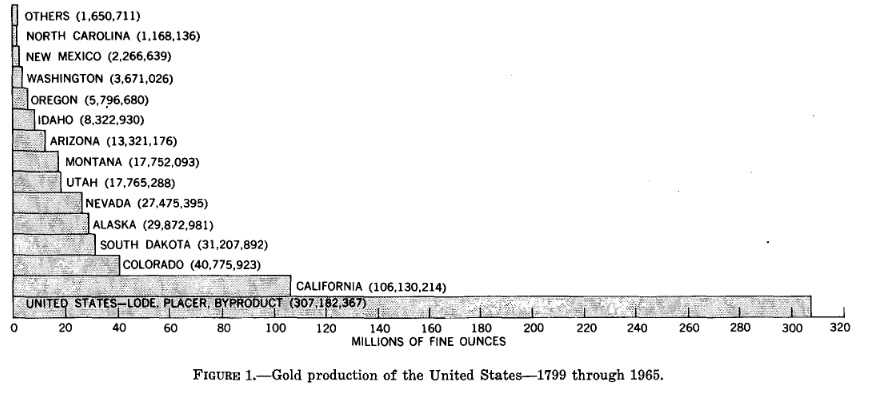
Check out the video about Large mining operation near Fairbanks, Alaska, 1950s:
Sources: Alaska Miners Association, Library of Congress, USGS
How Much Gold Has Been Mined in Alaska?
Alaska produced a total of 54 million ounces of gold from 1880 through the end of 2022.
Gold prodcution through the times went up and down considerably, as the next chart shows, with production numbers from 1880 till 1965 (from the book Gold producing districts of the United States, 1968).
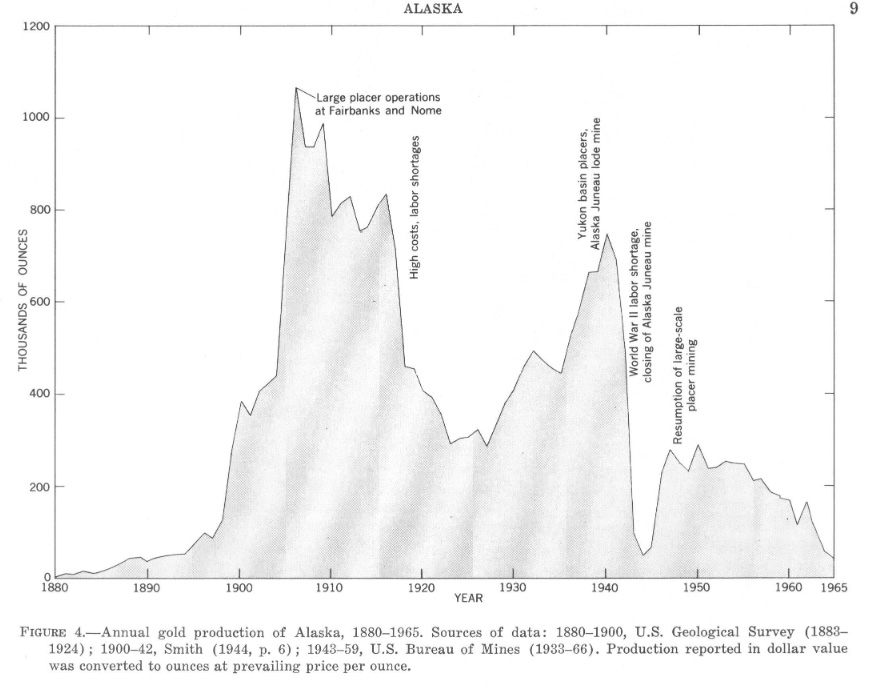
2013 was a record year with production the first, and only, time above one million ounces (1,022,987).

Source: Alaska’s Mineral Industry 2020, USGS
What is the Current State of Gold Mining in Alaska?
The late 20th century saw a shift toward large-scale, industrial gold mining operations. Mines like Fort Knox and Pogo emerged as significant players in the Alaskan gold mining industry.
Unique about Alaska gold mining industry is its placer industry: besides large scale operations, as found in the other gold mining states of the US, there is a small-scale placer mining industry. In 2014 output averaged 8% of the total gold produced in Alaska. These operations are seasonal and often family operated since several generations. Significant placer gold can be found all over Alaska; see image.
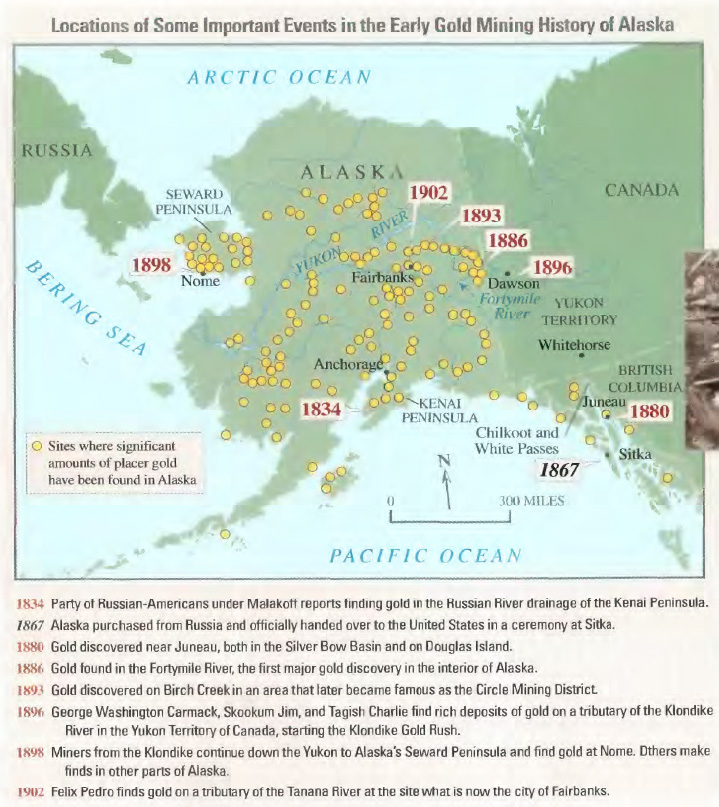
Modern industrial gold mining in Alaska utilizes advanced technology and methods, including hard-rock mining, open-pit mining, and large-scale placer mining.
These practices reflect a balance between economic interests and environmental considerations, as gold mining continues to be a major economic driver for the state. This historical journey from the first gold discovery to the present-day mining landscape highlights Alaska’s enduring connection with gold, shaping both its economy and its identity.
What are the major gold mines in Alaska?
The US Geological Survey Minerals Yearbook lists in its most recent overview 4 leading gold producing operations in the state of Alaska: Fort Know (owned by Kinross Gold, Pogo (Northern Star), Kensington (Coeur Mining) and Greens Creek (Hecla Mining).
After Nevada, with 27 operations, Alaska takes the second spot in terms of number of operations and gold output in the United States.
Complete list and facts and figures of the 4 major gold mining operations in Alaska:
| Rank | Mine (Location) | Majority Owner | Qty 2021 (2020) |
|---|---|---|---|
| 5 | Fort Knox (Eastern Interior Region) | Kinross Gold Corp. | 8.220 (7.400) |
| 13 | Pogo (Eastern Interior Region) | Northern Star Resources Ltd. | 5.860 (6.400) |
| 17 | Kensington (Southeastern Region) | Coeur Mining, Inc. | 3.770 (3.880) |
| 23 | Greens Creek (Southeastern Region) | Hecla Mining Co. | 1.430 (1.510) |
Explanation:
Rank: a comparison of the output of US mines. Therefore, Fort Knox, with the highest output of the Alaska mines, is ranked number 5 of all US gold mines. Eight of the ten biggest mines are in Nevada. The remaining two are in Alaska and Colorado.
Quantity: in kilogram; there are approx. 32 fine ounces in one kilogram
Based on the table above, the following overview lists the gold operations with more information. Sorted by annual gold output:
- Fort Knox: single open pit gold mine in Alaska, located 26 miles northeast of Fairbanks, in the Easter Interior Region. Small scale placer mining in that area since 1903. The current mine went into operation in 1996. Bought by Kinross in 1998 (operated by subsidiary Fairbanks Gold Mining). 2021 gold output was 8.220 kg. Mine life until 2030.
- Pogo: also called Northern Star Pogo is an underground gold mine located 85 miles southeast of Fairbanks, located in Eastern Interior Region. Gold discovered in 1995 and mine commenced production in 2006. Owned by Northern Star Ressources since 2018. Expected mine life until 2026. Gold production in 2021 stood at 5.860 kg.
- Kensington: underground vein-stlye gold mine located 45 miles northwest of Juneau, in the Southeastern Region of Alaska. It consists of several vein systems including the Kensington main deposit, Raven, Jualin, Eureka, Elmiar and other deposits. The mine is owned by Coeur Mining (through its subsidiary Coeur Alaska), bought in 1987 and 2010 a 50% stake. Mining was paused from 1928 and commenced only in 2010. Gold production in 2021was 3.770 kg of gold. Mine life until 2025.
- Greens Creek: underground mine producing silver, zinc, gold and lead. Location in the Admirality mining district in the Southeastern Region. It is the largest silver mine in the US. Deposits discovered in 1975, production from 1989 to 1993 and from 1995 to this day. Gold produced in 2021 was at 1.430 kg. Owned by Hecla Mining. Mine Life 2036.
Sources: USGS, University of Alaska Southeast, miningdataonline, Alaska Geological & Geophysical Suverys, company websites
What is the biggest gold mine in Alaska?
The biggest gold mine in Alaska is the Fort Knox open pit mine (see image below). It is located 9 miles from Fairbanks in the Fairbanks mining district. The mine is owned and operated by the Canadian mining company Kinross Gold.
The area of the current mine was already staked in 1913. But only after the purchase by Amax Gold in 1992, industrial-scale production began.
Some facts:
- Gold production for 2022 stands at 291.248 ounce of gold
- The mine’s west of Gilmore expansion extends the mine life to 2030
- Further production growth through the addition of the Manh Choh project (production start in 2. part of 2024)
- Gold resources (reserves, measured, inferred) stand at 4.816m ounces, plus 0.927m ounces from the Manh Choh project. In total 5.743m ounces

Source: Alaska Division of Geological & Geophysical Surveys, Kinross Q3 2023 reportings.
How Many Gold Reserves are in Alaska?
The four gold mines in Alaska have gold reserves of aound 18m ounces (see table below). This includes measured, indicated and inferred estimations. However, this is the lower end of the estimate. Over the last years, the mines have been expanded, unlocking more gold. The same can be expected in the future.
Further, this estimate does not include gold projects that are being explored or developed. Here, the Donlin project stands out: It is supposted to be one of the largest undeveloped gold mines in the world.
Therefore, Alaska still has much more than 18m ounces of gold reserves.
For the four active gold mines, the gold reserves are stated as follows:
| Mine | Reserves in m ounces* |
Comments |
|---|---|---|
| Fort Knox Mine | 5.743 | Includes Manh Choh project |
| Pogo | 9.000 | Ore reserves and all resources |
| Kensington | 1.699 | |
| Green Creek | 1.923 | |
| Total | 18.365 |
Gold reserves incl. measured, indicated and inferred
Source: Alaska Division of Geological & Geophysical Surveys
What Companies Mine Gold in Alaska?
Each of the gold operations listed above is owned by a different company: Kinross, Northern Star Ressources, Coeur Mining and Hecla Mining. They are publicly listed and domiciled and the United States, Canada or Australia. Alphabetically:
- Coeur Mining, Inc.: a Chicago-based silver and gold producer. It was founded in 1928. Operations in Alaska (Kensington; gold), Nevada (Rochester; silver and gold), South Dacota (Wharf; silver and gold), Mexico (Palmarejo; silver and gold) and the Silvertip Exploration Project in Britsh Columbia (silver, zinc and lead).
- Hecla Mining Co.: largest silver mining company in the US. It also mines gold. Hecla Mining was founded in 1891 and is headquartered in Coeur d’Alene in Idaho. Its operating mines are in Alaska (Greens Creek; largest silver mine in the US, also gold, lead and zinc), Idaho (Lucky Friday; silver, lead and zinc), Quebec (Casa Berardi; silver and gold) and Yukon Territory (Keno Hill; silver). 10 exploration projects mostly in the US, but also Canada and Mexico
- Kinross Gold Corp.: owns the biggest gold mine in Alaska; the company was founded in 1993 and is based in Toronto. Four operations in the US (Alaska, Nevada, each two), one in Brazil (Pracatu), two in Chile (Atacama region) one in Mauritania and one exploration project in Canada.
- Northern Star Resources Ltd.: an Australian-based gold mining company that was founded in 2003. Productions in Australia (Kalgoorie and Yandal productions) and Alaska (Pogo).
Sources: company websites
Where are New Gold Mines Explored or Developed in Alaska?
| Mine/ Project Name | Method | Stage | Owners |
|---|---|---|---|
| Donlin Gold Project | Open Pit | Feasibility | Barrick Gold; NovaGold Resources |
| Livengood Project | Open Pit | Construction | International Tower Hill Mines |
| Niblack | Underground | Exploration | Heatherdale Resources |
| Pebble Project | Open Pit | Feasibility | Northern Dynasty Minerals |
Sources: Mining Technology, University of Alaska Southeast
Is it Legal to Mine Gold in Alaska?
Gold mining in Alaska is legal, but it is subject to regulations and permits from federal and state agencies. Recreational gold panning on lands withdrawn from mineral entry is considered a privilege and not a mining activity.
The Bureau of Land Management (BLM) in Alaska oversees mining activities and issues permits for mining operations. Both federal and state governments have dual roles of encouraging use and protecting resources on public lands, and mining is highly regulated, often requiring multiple permits.
It is illegal to engage in any mining activity in Alaska without an Alaska Department of Revenue (ADOR) issued mining license, which is required for all mining operations on state, federal, municipal, and private land. Despite the legality of gold mining in Alaska, there have been legal challenges and opposition from Alaska Native tribes over concerns about health and environmental impacts, as seen in the case of the Donlin Gold project.
Sources: Burea of Land Management, forbes
Where Can I Pan for Gold in Alaska?
Check out the video about gold panning at Gold Creek in Juneau, Alaska:
There are countless gold panning opportunities in Alaska. Almost every major town or city in Alaska has gold mining as a part of its history. Some popular spots include:
- Crow Creek Mine, Girdwood: Crow Creek Mine in Girdwood offers gold panning tours, providing an authentic experience in a historically significant location. Visitors can learn about the area’s gold rush history and try their luck at finding gold in the same place where miners struck it rich during the Klondike Gold Rush
- Indian Valley Mine, Anchorage: Located approximately 20 minutes south of Anchorage, Indian Valley Mine offers gold panning experiences and a glimpse into Alaska’s mining heritage. Visitors can immerse themselves in the art of gold prospecting while learning about the state’s rich mining history.
- Denali Gold Tours, Talkeetna: Denali Gold Tours near Trapper Creek provides an opportunity to learn and practice gold panning in pristine water. Visitors can spend a half-day or full-day in the beautiful Alaskan countryside, guided by experts who share old-timer panning techniques and stories from the dramatic days of Alaska’s gold rush.
- Gold Rush Peck, Hope: Gold Rush Peck in the town of Hope offers an authentic gold panning experience with one-on-one attention from a lifelong miner. Visitors can choose from different bucket sizes and have the chance to find real gold in a rustic and historically rich setting.
- Gold Dredge 8, Fairbanks: Gold Dredge 8 is historically known for its gold extraction and is a popular destination for trying gold panning in northern Alaska. Visitors can learn about the area’s gold mining history and try their hand at gold panning with the guidance of Alaskan miners, potentially finding real Alaskan gold to take home.
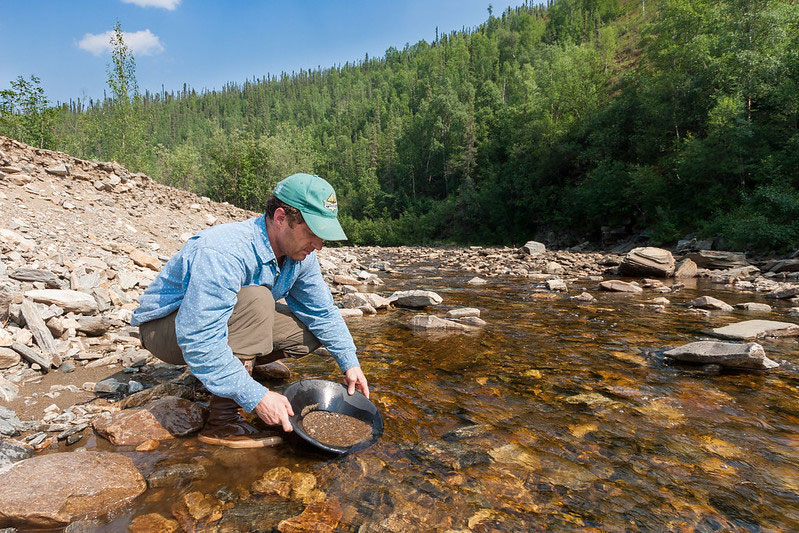
Is There Gold in Other US States?
According to the U.S. Geological Survey (USGC), there are 11 states that mine gold and contribute towards the gold mining statistic: Nevada is responsible for the majority of gold output, around 72%, followed by Alaska (13%). 9 other contribute in sum to the remaining 15% of gold production: Arizona, California, Colorado, Idaho, Michigan, New Mexico, South Carolina, South Dakota, and Utah.
